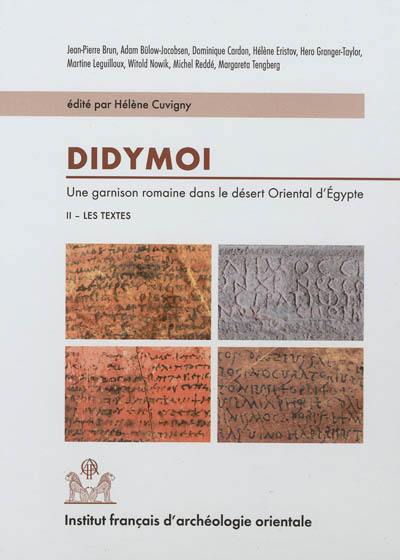
Fiche technique
Format : Relié
Nb de pages : XV-453 pages
Poids : 2418 g
Dimensions : 25cm X 33cm
ISBN : 978-2-7247-0586-7
EAN : 9782724705867
Les textes
Quatrième de couverture
Le second volume de la publication de Didymoi rassemble le matériel inscrit : inscriptions lapidaires, ostraca (y compris figurés), petits objets (les photos des ostraca sont publiées en ligne sur le site de l'Ifao). Parfois datés, ces témoins contribuent à la compréhension des architectures et des stratigraphies de Didymoi, analysées dans le premier volume. Aux deux extrémités de l'empan chronologique, la dédicace du fort (76/77p) et la copie d'une circulaire destinée à annoncer aux garnisons du désert de Bérénice la bonne nouvelle de l'association du César Maxime au pouvoir impérial (236p). Outre les documents générés par la routine du service et du ravitaillement (journaux de poste, laissez-passer, ordres de livraison, comptes, tituli vasculaires), les lettres privées envoyées des garnisons voisines abondent en instantanés sur la vie des militaires stationnés dans les fortins du désert Oriental et sur celle des civils, qui tempéraient l'inconfort et l'ennui de cette affectation. Un marchand préfère vendre sa viande à Bérénice malgré la demande locale, un helléniste compose péniblement une lettre en latin au moyen d'un glossaire ; tel débouche une amphore pour remercier le camarade venu du fortin voisin l'aider à faire son pain ; un curator praesidii a été prié par ses hommes d'écrire à un proxénète pour passer commande de sa «petite esclave, celle à soixante drachmes» ; un homme félicite une nouvelle accouchée ; il a, en action de grâce, allumé une lampe à Aphrodite ; un cavalier s'inquiète pour un jeune chien qui l'a suivi alors qu'il s'éloignait à cheval et qui n'est pas rentré au fort. Dans les installations romaines du désert Oriental, les documents demeurés sur place - parce qu'ils ont été mis au rebut - ne sont pas les sources dont rêve l'historien. Une synthèse liminaire fait le point sur ce qu'ils apportent néanmoins à la connaissance du maillage militaire dans cette zone de transit caravanier.
The second volume of the publication of Didymoi contains the inscribed material, such as inscriptions on stone, ostraca with text or images, and small objects (the photos of the ostraca are published online on the Ifao website). As they are sometimes dated, these objects contribute to the understanding of the architecture and stratigraphy of Didymoi that was published in the first volume. At the extremities of the chronological span we have the dedication of the fort (AD 76/77) and the circular letter to the garrisons of the desert of Berenike announcing the good news that Maximinus Thrax promoted his son to Caesar (AD 236). Apart from the documents generated by the military routine and the provisioning of the fort, such as postal registers, passes, orders to deliver, accounts, and inscriptions on jars, there are a great many private letters sent from neighbouring stations. These letters give us snapshots of the life of the soldiers who were stationed in the forts of the Eastern Desert and of the civilians who mitigated the boring discomfort of this service. A merchant prefers to sell his meat in Berenike in spite of local demand. A Greek speaker painstakingly writes a letter in Latin with the help of a glossary. Someone opens a jar of wine to thank a friend who has come from a neighbouring fort to help him make his bread. A curator praesidii has been asked by the men to write to a procurer to order 'your girl who makes you sixty drachmas'. A man writes to congratulate a woman on the birth of her child, saying that he has lit a lamp to Aphrodite in gratitude. A horseman is worried about a young dog that followed his horse when he left the fort, but has not come back. In the military establishments of the Eastern Desert the documents that remain to be found have remained because they were thrown away, and are not the sources that historians dream of. Nevertheless, an introductory chapter gives a synthesis of what they do contribute to our knowledge of the military network in this zone passing caravans.






